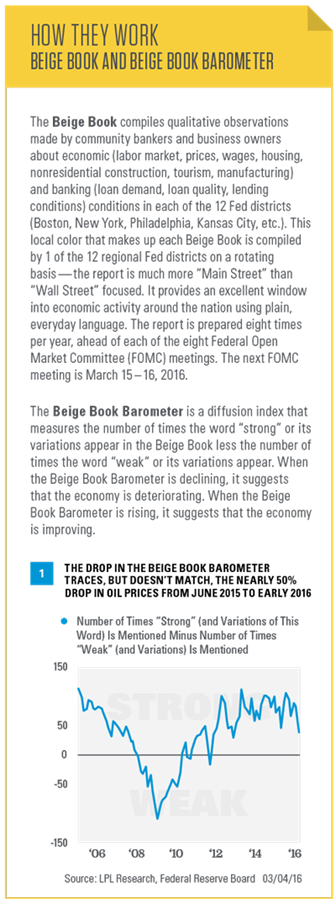The latest Beige Book suggests that the U.S. economy is still growing near its long-term trend, but that the drag from a stronger dollar and weaker energy prices, along with the slowdown in emerging market (EM) economies—most notably China, are still having a major impact on the manufacturing sector. In addition, our analysis of the Beige Book confirms that there has been some spillover of weakness from the energy and manufacturing sectors to other parts of the economy in recent months. Comments in the Beige Book also continue to indicate that some upward pressure on wages is beginning to emerge; but the wage pressures are not accelerating, which should keep the Federal Reserve (Fed) from raising interest rates aggressively this year.

The Beige Book is a qualitative assessment of the U.S. economy and each of the 12 Fed districts individually. We believe the Beige Book is best interpreted by measuring how the descriptors change over time. The latest edition of the Fed’s Beige Book was released Wednesday, March 2, 2016, ahead of the March 15–16, 2016 Federal Open Market Committee (FOMC) meeting, the second Fed policy meeting of 2016. The qualitative inputs for the March 2016 Beige Book were collected from early January 2016 through February 22, 2016. Thus, they captured Main Street’s reaction to:
§ A period of extreme volatility in U.S. and global financial markets
§ Heightened fears of a U.S. and global recession
§ Several 25%+ swings in oil prices
§ The announcement by the Organization of the Oil Exporting Countries (OPEC) of an oil production “freeze”
§ Another wave of capital spending cuts by U.S. energy-producing companies
§ Economic and inflation data for December 2015, January 2016, and February 2016 that were mixed at best for the U.S. and generally much weaker than expected overseas, especially in Europe
§ Increased discussion in the financial media about global deflation and negative interest rates








